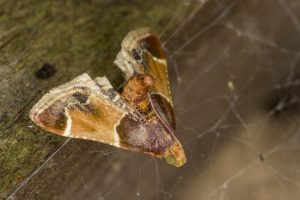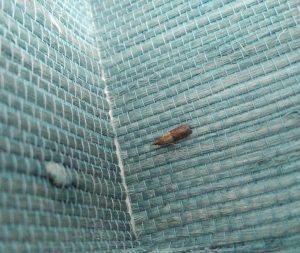FOOD MOTH INFESTATIONS AREN’T ALWAYS IN THE KITCHEN
By Chris Williams on January 24, 2019.

Meal Moth. Shutterstock.
As always, you need to have a pest management professional inspect and identify your pests but Indian meal moths, or a related moth, are a likely answer. These are food moths that infest a wide variety of stored food products such as cornmeal, spices, flour, nuts, and cereals. But they also feed on some items that we tend to overlook either because they are found outside of the kitchen or they are craft items made of food materials. Examples are Indian corn ornaments, bean mosaics, dried flowers, fish or turtle food, and especially birdseed and bulk dry pet food (see Can Food Moths Come From Bird Seed?).
PET FOOD AND BIRDSEED ARE OFTEN INFESTED
Is this storage closet where you store birdseed or a big bag of pet food? Infestations are most often traced to old or moldy food products that have been around for a while, so the source may be something you have forgotten about like a bag of chocolate Easter eggs! In unusual circumstances, the moths can be traced to food that has been hoarded by mice in wall voids or hidden nest areas. It seems pretty likely that the food source for the Indian meal moths is in the closet so a little more looking should uncover it.
What you are probably seeing are the mature Indian meal moth or other food moth larvae. Once they are fully developed, they usually leave the food source and wander away, looking for a protected place to spin a cocoon where they will pupate (see White Worms Crawling Up the Walls!). After several days, the gray and rust-colored Indian meal moths will emerge. In contrast, clothes moths are satiny beige (see Clothes Moths or Pantry Moths?). Indian meal moths will fly to lights, mostly at dusk, but clothes moths don’t.
THE INFESTATION CAN SPREAD TO OTHER ROOMS

Indian Meal Moth on textured dining room wall. Z. Ciras
Once the moths and their food source are eliminated from the closet, you still have to worry about whether female moths have laid eggs in and infested other foods in your kitchen or pantry. It’s even possible that the moth infestation originated in the kitchen and moved to the closet. The foods most likely to be infested are those that have been on the shelf the longest, or packages that have been damaged, overlooked, or stored in dark areas. Even unopened bags or packages can be infested. You’ll need to check or toss susceptible food items.
If evidence of infestation is found, discard the infested products and wash down shelves. You may want to have a pest control company treat shelves and other areas to kill any new larvae that may hatch from eggs in cracks and crevices.
Our Colonial technicians can help with all stages of a food pest infestation from pest ID, to inspection, to treatment, to follow-up monitoring, even advice on how best to store your food to keep it pest-free. It can take a while to completely eliminate food moths. Give Colonial Pest a call today before the infestation moves into new areas of your home.